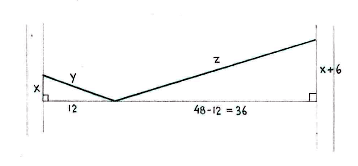Lösung 4.1:10
Aus Online Mathematik Brückenkurs 1
First, let's decide to determine all distance in dm (decimeters), so that we have all the distances as integers.
Call the length of the washing line from the trees to the hanger y and z, as in the figure below, and introduce two auxiliary triangles which have y and z as their hypotenuses. (As an approximation, we suppose that the taut washing line consists of two straight parts.)

Because the line is 54 dm long, we have
Then, the Pythagorean theorem gives the relations
Vorlage:Displayed math Vorlage:Displayed math
The idea now is to solve the system of equations (1)-(3) by first eliminating z, so that we get two equations which only contain x and y. Then, eliminate y from one of these equations, so that we get an equation which determines x.
From (1), we have \displaystyle z = 54-y, and substituting this into (3) gives us the equation
Equations (2) and (3') together give a smaller system for x and y,
Expand the quadratic terms on both sides of (3'),
and simplify
Use (2) and replace \displaystyle y^2 with \displaystyle x^2+12 in this equation,
which gets rid of the x²-term,
and further simplification gives the equation
If we pause for a moment and summarize the situation, we see that we have succeeded in simplifying the equation system (2) and (3') to a system (2) and (3"), where one of the equations is linear
In this system, we can make y the subject in (3"),
and substitute into (2),
This is an equation which only contains x, and if we solve it, we will get our answer.
Expand the quadratic on the left-hand side,
and collect together all terms on one side,
which gives the equation
Multiply both sides by \displaystyle 81/80 so that we get the equation in standard form,
Completing the square on the left-hand side gives
and then
i.e.
This means that the equation has the solutions
The answer is thus \displaystyle x=9\ \textrm{dm} (the negative root must be discarded).
To be sure that we have calculated correctly, we also look at the values of y and z, and check that the original equations (1) to (3) are satisfied.
Equation (3") gives
and equation (1) gives
Now, we check that \displaystyle x=9, \displaystyle y=15 and \displaystyle z=39 satisfy the equations (1), (2) and (3),
